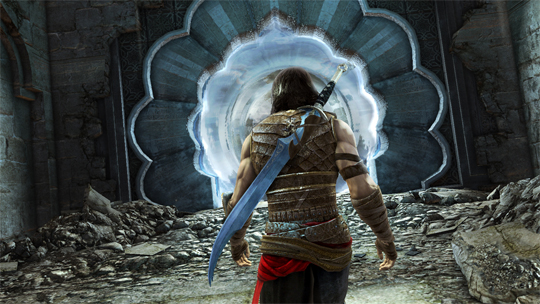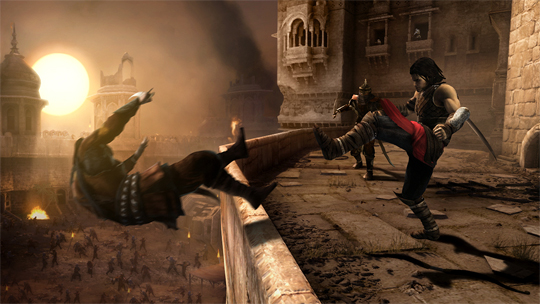I would advise anyone who thinks of Prince of Persia: The Forgotten Sands as a simple movie tie-in to change that preconception right away. Instead, think of Ubisoft Montreal’s latest middle eastern adventure as a return to the Sands of Time trilogy, with the familiar play mechanics that many thought were missing from the Prince’s 2008 outing, and as an accomplished, albeit minimally progressive entry into the respected franchise.
The Forgotten Sands takes place in the seven-year gap between The Sands of Time and Warrior Within, when the Prince’s brother once again releases the Sands of Time in a last ditch effort to defeat the powerful army besieging his kingdom. Obviously, this is not a good idea, and sets the stage for the Prince’s newest trials and tribulations. Although certain aspects of this plot — namely, the Sands’ origins — seem to contradict the franchise’s overall story, it is nevertheless interesting enough in its simplicity to keep the player moving forward, and will offend very few SoT veterans.

The level design and play mechanics also emphasize progress. The positioning of the camera very effectively directs players’ attention down the game’s linear tunnel of narrative and action, almost always focusing on the next usable aspect of the surrounding architecture. The smooth platforming action — running along walls, swinging from poles, leaping between columns, etc. — is once again complimented by a time-reversal power, as well as new abilities that solidify flowing water and recall long-deteriorated sections of the environment. The two new abilities greatly increase the potential for more complex platforming sequences, especially late in the game, when they are strung together in increasingly lengthy combinations. It’s rewarding to skillfully navigate particularly complicated segments, and is usually not frustrating, a common concern when considering this type of game. This can be attributed to the rewind power that lets players instantly undo any mistakes, as well as the subtle anchoring of the Prince’s maneuvers to the proper environmental targets, which allows a margin of error for each acrobatic transition. Additionally, the controller layout is such that each button performs exactly one action at any given moment or in any given position, thus limiting confusion and input errors. It’s still quite possible to miss or mistime the Prince’s moves, but The Forgotten Sands finds a balance between old and new play philosophies by being streamlined and forgiving without holding players’ hands or revoking their sense of control over the on-screen action.
Combat in The Forgotten Sands is clearly intended to operate at an accelerated pace, acting somewhat antithetically to Ubisoft Montreal’s other recent action-platformer, Assassin’s Creed II. With no block button, but rather a quick roll, kicks, knockdowns, a few different aerial attacks, and elemental Djinn magic, players have a variety of options during these very active battles. Stylistic additions such as ground executions and context-sensitive finishing animations (stab against the wall, clothesline over a railing, etc.) keep things interesting, as well. With so many enemies on the screen at once, the game can occasionally feel like it boils down into a mash-fest during certain segments, but the inclusion of a basic experience system and skill tree to unlock and upgrade abilities is a solid motivator, and Ubisoft Montreal has again struck a balance between combat and platforming throughout the adventure.

Ubisoft’s primary mistake with The Forgotten Sands is a save system that is functional in theory, but is flawed in reality. Players cannot manually save the game at all. This means that it is impossible to repeat specific parts of the game without restarting from the very beginning, but it also provides the necessary conditions for a nasty glitch that is partially game-breaking. Just prior to the game’s conclusion, a deadly fall can cause the game to reload an auto-save from earlier in the area that eternally traps the Prince in a hall full of pendulum blades and no doorway to freedom. If not for the game’s backup save, which can only be accessed by manually deleting the main save in the 360’s (and presumably the PS3’s) memory management menu, players would have to restart the game from the beginning. Instead, using the backup save loses about an hour’s worth of progress, which is very uncool and a disappointing oversight, rather than being absolutely and unforgivably unacceptable.
Prince of Persia: The Forgotten Sands may not represent a revolution for the franchise, but it is certainly a welcome return to form, and comes with a number of updates and improvements to create a smooth and enjoyable experience. The Prince himself isn’t as charismatic as he once was, and the narrative is somewhat thin, but players looking for fun will find it in this game’s very satisfying platforming action and combat. This is not a "movie game."


















